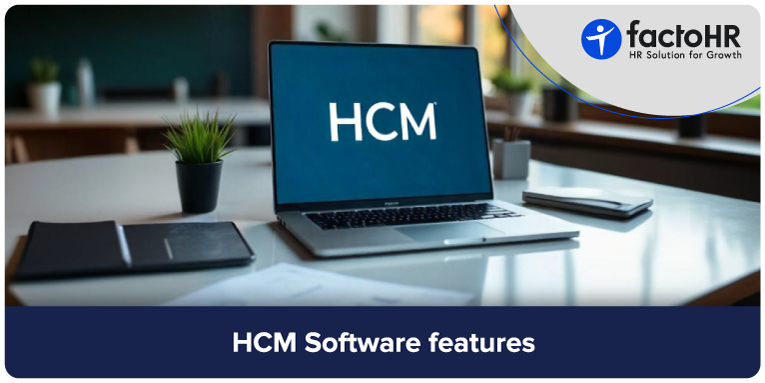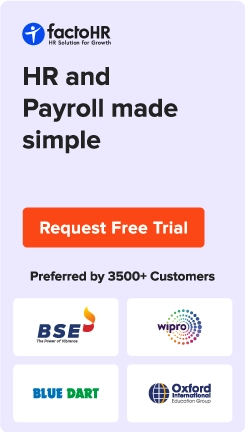Top HCM Software Features to Look for in 2025

Table of Contents
Workforce management is complex, especially at a time when remote and hybrid work arrangements are the new norm. Evolving employee preferences and AI-led transformations are making workforce management more nuanced. 80% of organizations now offer flexible work arrangements to meet employees’ desires for adaptability. We aren’t still listing already prevailing challenges, such as managing compliance with different regional regulations and calculating salaries for a large organization.
In such situations, an HCM platform becomes even more important, as it streamlines key HR operations, including payroll and compliance management, performance evaluation, and talent acquisition. Cloud-based HCM solutions automate manual tasks, such as tax deductions, accrual calculations, and attendance tracking, among others. This saves time and increases the operational efficiency of an organization.
In this blog, you will learn about Top 10 HCM software feature and will be able to choose the right HCM platform for efficient workforce management.

10 Must-have HCM Software Features in a 2025
The HCM platform streamlines people management by offering various features, including an employee self-service portal, integration with internal and external systems, and automated payroll processing.
AI-powered features, such as chatbots and predictive analytics, are also essential, as they support strategic HR management. Let’s explore these HCM software features in some detail.
Core HR Functionality
An HCM platform should streamline core HR operations, including onboarding, payroll management, performance assessment, and time and attendance monitoring. The system must securely store and manage employee data online, ensuring a seamless and paperless onboarding experience.
Additionally, HCM software should automate the majority of payroll functions, including calculating arrears and managing tax deductions. It should enhance the performance review process through features like continuous feedback. Furthermore, the HCM system needs to include an integrated time and attendance platform for accurate time tracking.
AI and Predictive Analytics
Human capital management software should incorporate AI-powered features to support a future-ready workforce. AI in HR could simplify tasks and address workforce gaps. For example, an AI-powered chatbot could resolve basic employee queries. Similarly, predictive analytics in HR could help forecast future needs by combining historical data, statistical models, and machine learning.
- Historical data is collected records and information about past events.
- Statistical models are mathematical frameworks that apply statistical techniques to analyze historical and current data.
- Machine Learning is a branch of AI that enables systems to observe patterns and forecast future outcomes based on observed trends.
Employee Experience and Self-Service Portal
The software should provide a personalized employee experience with the Employee Self-Service (ESS) portal. The ESS portal should enable regular pulse surveys, allow attendance correction and leave application, and support impartial performance reviews with 360-degree feedback.
Automated Compliance and Statutory Updates
Keeping track of the ever-changing legal landscape becomes difficult, particularly for firms operating in multiple states and countries. Features such as real-time updates on changes in employee laws, automated tax compliance, and digital reporting are essential must-have HCM software features. Real-time updates help configure organizational policy.
Automated tax compliance ensures error-free tax deductions and saves time. Digital records would be helpful during compliance-related audits. An HCM platform should also have secure cloud centers for storing employee information to adhere to data protection laws.
Performance and Feedback Modules
Features such as continuous feedback, multiple goal creation, and integrated learning management systems could significantly improve the performance review process. Continuous feedback would help reinforce organizational goals and facilitate steady employee growth by identifying potential areas for improvement.
Creating multiple goals can help establish both primary and secondary objectives, thereby improving overall goal alignment. Integration with the learning management system would enable the design of tailored development programs for upskilling staff.

Time Off and Leave Management
Two important HR operations are tracking employee time off and managing employee leaves. Poor time-off tracking can lead to issues such as absenteeism and errors in payroll calculations. Inefficient leave management can lead to workforce disruptions and delays in achieving goals.
Features such as integrated attendance and leave modules, as well as a team leave calendar, are essential for any HCM platform. A team leave calendar would provide total visibility about the current staff availability, assisting in workforce scheduling. Integrating various modules such as attendance, leave, and payroll is critical to avoid reconciliation errors.
Integration with Other Business Tools
Human capital management software should seamlessly integrate with built-in modules and external systems. Payroll, performance, leave, and attendance modules should have off-the-shelf integration to streamline related HR functions. Similarly, an HCM platform should be able to integrate with other ERP and accounting systems, such as SAP, Tally, and QuickBooks.
Customization and Configurability
HCM software should have customizable components. A flexible rule engine is necessary for configuring different salary structures for different employee positions. Similarly, configurable leave policy components are crucial for granting employees fair leave entitlements. Organizations should be able to customize reports related to payroll and performance for better decision-making. Thus, customizability and configurability are two important features of an HCM platform.
Engagement and Wellness Tools
Employee well-being is crucial for a productive and conducive work environment. Features such as pulse surveys, mood trackers, and chatbots for resolving employee queries would help increase employee engagement and improve organizational productivity. Pulse surveys would facilitate active employee participation in organizational events.
Mood trackers enable employees to report potential workplace issues to the relevant authority. Similarly, utilizing AI-powered chatbots would help resolve basic employee queries related to payroll, attendance, tax deductions, and other matters.
Data-Driven Decision Support
The HCM platform supports data-driven decision-making by facilitating access to key data related to talent acquisition and performance management. Analytics related to talent acquisition help understand the current workforce demands.
Information such as performance ratings, feedback, and reviews helps evaluate employee performance. As mentioned earlier, customizable reports and analytics related to performance would also be beneficial in other HCM activities, such as training and employee development.

Additional Considerations when Choosing HCM Software
Mobile accessibility, vendor support, and compliance with data privacy laws are some of the factors to consider when choosing an HCM platform.
Mobile Accessibility and Remote-Readiness
Your chosen HCM software should be mobile-friendly and facilitate the management of a remote workforce. The recent digital advancements have significantly altered jobs and working arrangements. Therefore, prefer cloud-based HCM solutions that offer features such as online attendance management and an intuitive mobile app.
Vendor Support and Implementation Services
Customer support and implementation are other must-haves for any HCM platform. 24/7 customer support would help address any queries at any time. Also, the HCM software should be easy to implement. Lastly, your employees should have extensive training sessions to make the most of your chosen solution.
Compliance with Data Privacy Laws
According to Forbes, more than 160 countries have adopted some form of data protection regulation, covering approximately 82% of the world’s population. This highlights the need to comply with data privacy laws. In such a scenario, features such as a secure cloud center and end-to-end encryption become even more important. Prefer solutions that are certified by authorities such as SOC and ISO.

Conclusion
An advanced HCM platform is essential for any organization. Human Capital Management Software increases operational efficiency by automating administrative tasks. It also aids in decision-making by offering features like real-time reports.
Organizations should consider advanced features such as AI integration when selecting a vendor. Learning about Human Capital Management in more detail would be a good starting point.
Grow your business with factoHR today
Focus on the significant decision-making tasks, transfer all your common repetitive HR tasks to factoHR and see the things falling into their place.

© 2025 Copyright factoHR


